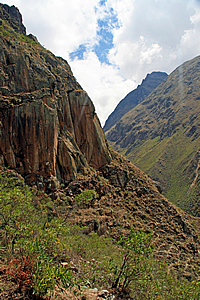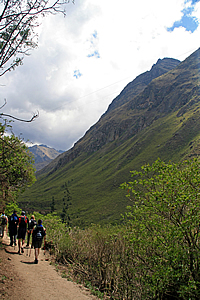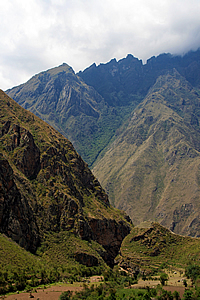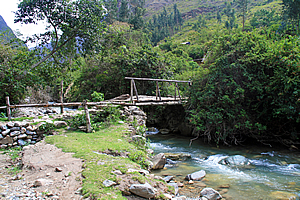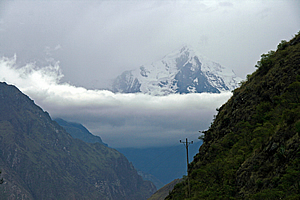--- Archive files ---
Home > Treks > Inca Trail > Day 3 > 3.5 |
The first of many Standing Ovations
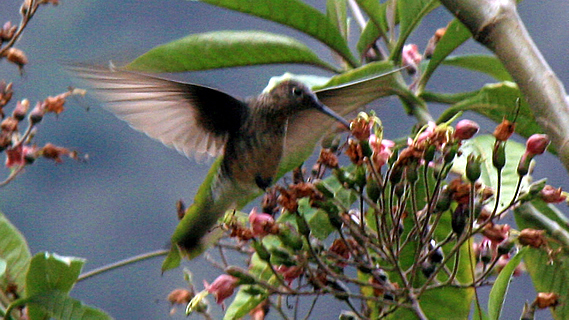
FROM our lookout over Pallacta, we followed the track towards the Cusichaca Valley. Two minutes later we closely passed the granite block fortification of Huillca Raccay before commencing a steep descent into the Cusichaca Valley. Fortunately the descent was only steep for about five minutes before the dusty track turned off to the left to follow the valley upstream. The track continued gently downhill eventually meeting the main track along one of the narrow terraces just metres above the Cusichaca River.
Towering cliffs where soildiers are buried |
The rock bluffs that towered vertically above the track were covered in bromeliads. They were a fairly plain species of bromeliad, but the plants were quite large with crowns about a metre wide. They seemed to be doing very well here perched on the small crevices in the cliff face they could lodge their roots into. Bromeliads also grew on the trees that littered the riverbank. The gravel track we walked along was now wide and of an easy grade. The river bank dropped about five to ten metres into the cascading river below us, cut into a deep burn. Above the bank on the other side was farmland perched on the valley floor terrace merging with the scrub covering the steep valley wall towering high up to the mountain. This valley had obviously been glacial during the major ice ages. Since the last ice age the river had cut a further ten metres into the valley floor.
Occasionally the track would negotiate its way over a large rocky bluff the river had cut into the mountainside. A row of wooden power poles with two cables ran along the valley near the track to supply electricity to the villagers further upstream.
Trail along the Valley |
Cusichaca Valley |
The valley floor became increasingly scrubby as we continued upstream. There were some interesting succulent like fan plants with huge stems leading up to small seed heads. Perhaps this is a relative of the New Zealand flax?
Bridge over the Cusichaca River |
We eventually reached a rickety wooden bridge crossing the river. Although it looked a bit suspect, it was very solid with two large logs spanning the width of the river banks. Upon these logs were large timber slats strong enough to hold a vehicle. The branches of fallen trees made up the framework and hand railing on either side of the bridge. Despite it looking so rickety, it was very stable providing an excellent walking surface to walk across with ease to the other side of the river.
Once across the river, we continued walking upstream along the trail. There was a small village ahead of us nestled deep in the valley with the precipitous mountains towering into the cloud that had covered over us in the past half an hour. This was the village of Wayllabamba, with a population of around four hundred people. I couldn’t imagine how so many people could live up in this remote village, and I had no idea what they did. After all the fifteen farmers living in the valley could barely support themselves with the poorly producing farmland yet alone be able to support the villagers. Perhaps some of the villagers were employed to maintain the trail and its campsites.
|
Once we were in the village, Wilbur suddenly turned off to the right and led us onto a small grassy patch. To our surprise, our blue porters were giving us a standing ovation as we arrived. Now that was a big surprise and very welcome. I’ve never received a standing ovation for completing a morning’s walk before. Walking is generally a thankless activity where it’s every man for himself. In Australia where everyone has a love affair with their cars, walking is almost considered criminal. It was therefore such a nice unexpected surprise to receive a standing ovation upon arrival.
|
The porters’ backpacks were nicely laid out along the sides of the grassy clearing. Some of them had been unpacked with one large blue tent had been erected with a long plastic dining table running down the middle and plastic backless seats on either side. This was a most impressive effort.
To the right of the tent was a row of plastic bowls. One of the porters was pouring warm water from a large metal cooking pot into the bowls. A few off the other porters were cooking lunch nearby.
|
A porter directed us to the bowls of water and gave us each a small bar of soap to wash our hands in preparation for lunch. We all washed our hands in the bowls and sat on a large blue tarpaulin they had laid out for us. Here we sat and talked waiting for lunch to be served. A couple of porters poured some red cordial into plastic cups and gave them to us. The cloud overhead thickened and the humidity rose, but fortunately it wasn’t raining yet.
I took a few photos of the village. Some houses had thatch roofing but most were roofed had a patchwork of rusty corrugated iron with stones sitting on them to keep them in place in stormy weather.
|
The memory card in my camera ran out of memory. Fortunately it was only the backup two gigabyte card, so I replaced it with the empty eight gigabyte card. This card should last me all the way to Machu Picchu. I’m sure none of the Inca had to contend with this sort of issue with technology, but I was intent on documenting this trip as best I could. That being said though, I only had three batteries with me to last me four full days until returning to Cuzco after visiting Machu Picchu. Luis had mentioned there is a place at our campsite on the night before going to Machu Picchu where we will be able to have our batteries recharged, but I wasn’t counting on his advice. That would be a great bonus, but what if the power wasn’t working there as is often the case in remote locations? These batteries had to last the entire hike.
Wilbur gestured to me and took my camera. He had obviously seen something. This had better be good – I had to make the camera last four days. I quickly followed him until he reached a small tree where a small hummingbird was hovering around its flowers. Wilbur took a few shots and fortunately one of them came out very well. It is very difficult to get a good picture of a hummingbird as they flap their wings so fast that they would appear a transparent blur unless you got the shot at precisely the right moment when the wings are fully open. There is no way you can develop the skills to get the right shot at the right moment. Wilbur had amazingly fluked the one in a hundred shot.
|
Wilbur and I returned to the tent. By now lunch was ready to be served, so we took our seats on the small backless plastic seats. The table had a blue Intrepid tablecloth on it – a clever little marketing gimmick to advertise the quality of the food served on their trips. On the tablecloth they had perfectly put folded serviettes and stainless steel cutlery – knife, fork and spoon. Suddenly we were taken from the remote alpine village hike to a classy restaurant. The porters served us chicken soup in small aluminium bowls. There were also a couple of large bowls containing fresh small buns – the South Americans obviously love their bread.
|
Now Michael was on a special diet having come down with food poisoning in the Amazon a few days ago. He had seen a doctor in Cuzco and the porters had prepared special food for him to minimise the chances of his stomach getting upset again. He had managed to keep up with us this morning, though a little slow going up the hill from the village where we had rested in the shade. I’m sure the walk must be torture for him though.
|
After soup, several large plates were put out along the length of the table. Now I would have expected reconstituted rice risotto and freeze dried meat as I had done in previous hikes. What we got was worlds away from that. Firstly came a large bowl of penne pasta. This was quickly followed by seasoned fried fish pieces. Then there were mixed vegetables – beans, carrot and cauliflower. Finally came a large bowl containing fresh lettuce and tomato salad. This was a full on restaurant meal. This was a huge bonus given we had just completed a long morning’s walk at high altitude.
It was apparent now this trek was going to be very luxurious.
|
After lunch, we left the tent while the short stocky and well built porters quickly washed up and packed up. We watched them pack their backpacks as we lay down on a slope in the ground drinking more red cordial. Hopefully the red food colouring in the cordial here wasn’t going to keep us up all night. One porter had all the plastic seats stacked up with the space in between filled up with glasses and cutlery. He tied it all together with a rope and put it all into a large sugar sack.
Stormy weather back in the Urubamba River |
It was incredibly ingenious despite its crudeness. I hoped it was comfortable for him.
I looked down the valley which we had come from this morning. The glacial slopes of Mount Veronica were still visible above a very ominous looking black cloud now filling the valley. It would be raining in the Urubamba River along the Sacred Valley now. No doubt the rain will be coming up this valley very soon.
<< Previous | Next >> |
|
||
About this Page
|
||
|
|
|
Where is Walkabout Jeff? |
|
|
|
|
What is happening in Walkabout Jeff's hometown?
|
|
|
|
|
Who is Walkabout Jeff?Any normal person's idea of going out involves going to the local pub for a drink with a few mates. Walkabout Jeff isn't normal.
|
|
|
|
|
